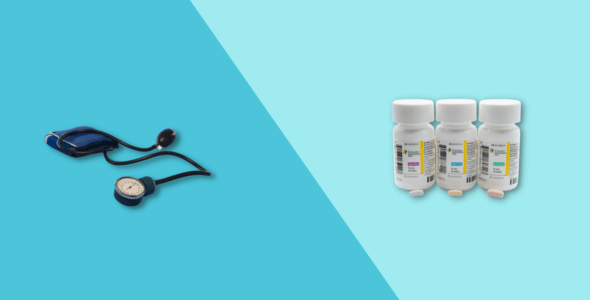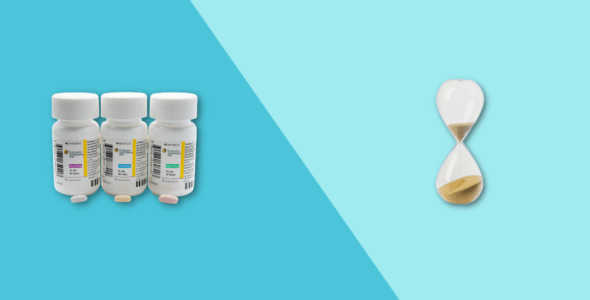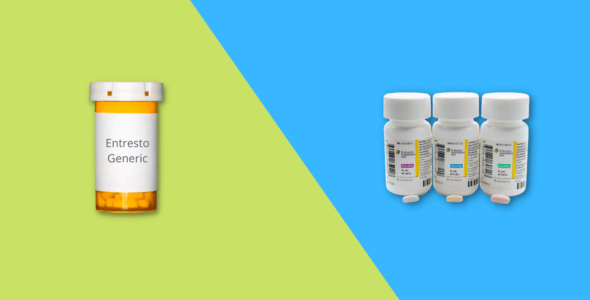Does Entresto improve ejection fraction?
Table of contents
Entresto (sacubitril/valsartan) is a prescription medication used to reduce the risk of cardiovascular death and hospitalization and improve the quality of life in adult patients with chronic heart failure. It is also used to treat pediatric heart failure patients, 1 year of age and older.
Here we will take a look at what heart failure and normal ejection fraction is, what Entresto is, what it’s used for, how to take it, how it works, its side effects, and some commonly asked questions about it.
What is a normal ejection fraction?
Ejection fraction is a measure of how much blood the left ventricle pumps out of the heart with each contraction. Normal ejection fraction according to the American Heart Association (AHA) is around 50% to 75%. If your left ventricle is not working normally a reduced amount of blood is pumped out of your heart.
If your ejection fraction is 50%, that means that half of the blood in your left ventricle is being pumped out with every contraction. Those suffering with heart failure will have ejection fraction of around 40% or less.
What happens in heart failure?
Heart failure (also known as congestive heart failure) happens when the heart is not able to pump blood around the body as it normally would, and usually occurs when the heart has become weak. This causes fluid to accumalate in the lungs causing symptoms such as difficulty breathing. Fluid build up may also cause swelling in the legs and feet. Heart failure is associated with many other diseases such as diabetes, coronary artery disease, hypertension, heart disease (cardiovascular disease), and aging.
The severity of your heart failure is often based on the New York Heart Association (NYHA) classification:
- Class I – no symptoms observed
- Class II – normal daily activities can be carried out without encountering problems but may become tired or out of breath when pushed
- Class III – difficulty completing daily activities
- Class IV – shortness of breath even when resting
What is Entresto used for?
Entresto (sacubitril/valsartan) is a prescription angiotensin receptor neprilysin inhibitor (ARNI) manufactured by Novartis Pharmaceuticals. Entresto is the first drug to directly treat patients with heart failure with preserved ejection fraction. It is approved by the U.S. Food and Drug Administration (FDA):
- To reduce the risk of cardiovascular death and hospitalization for heart failure with reduced ejection fraction (HFrEF) in adult patients with chronic heart failure (New York Heart Association) NYHA Class II-IV). HFrEF is also sometimes known as systolic heart failure. Entresto is more beneficial in patients with below-normal left ventricular ejection fraction (LVEF)
- For the treatment of symptomatic heart failure with left ventricular systolic dysfunction in pediatric patients 1 year of age and older
How does Entresto work?
Entresto is an angiotensin receptor antagonist containing a combination of sacubitril and valsartan. Sacubitril enhances the natriuretic peptide system by neprilysin inhibition. By blocking the enzyme neprilysin, sacubitril prevents the breakdown of N-terminal pro-B-type natriuretic peptides (NT-proBNP) which helps lower blood pressure. This also causes an accumulation of the protein angiotensin II.
Entresto also blocks the renin-angiotensin-aldosterone system. Valsartan is an angiotensin II receptor blocker (ARB) that prevents angiotensin II from binding and causing vasoconstriction (narrowing of your blood vessels), and cardiac stimulation, among other blood pressure-raising effects. Valsartan is used along with sacubitril because it can block the effects of the accumulated angiotensin II.
This combined effect may help to improve heart function by reducing inflammation, cardiac fibrosis, and reducing cardiac remodeling.
What are the side effects of Entresto?
Some common side effects of sacubitril/valsartan in clinical trials include:
- Hypotension
- Hyperkalemia
- Cough
- Dizziness
- Lightheadedness
Some serious side effects of Entresto include:
- Angioedema
- Worsening kidney disease or function, especially in those with congestive heart failure (CHF)
- Angioedema (swelling of your face, lips, tongue, and throat) and hypotension (low blood pressure)
- Allergic reactions – discontinue Entresto immediately and seek medical advice if you have symptoms such as hives, trouble breathing, or swelling of your face, lips, tongue, or throat
- Increase in potassium levels. Before using potassium supplements or salt substitutes that contain potassium, consult your healthcare provider
You can report any side effects you experience to the FDA at 1-800-FDA-1088 or www.fda.gov/medwatch.
How is Entresto used?
- Take Entresto exactly as your healthcare provider prescribes it
- Entresto’s usual starting dose is 49 mg/51 mg taken twice a day. Your doctor may start you on a lower starting dose or change your dose during treatment
- If your child can’t swallow tablets, your pharmacist may be able to prepare Entresto as a liquid suspension at the recommended tablet dosage. Please note the suspension will also contain Ora-Sweet SF and Ora-Plus. Shake the suspension well before each use
- If you miss a dose of Entresto, take it immediately. If it is close to your next dose, do not take the missed dose. Take the next dose at your regular time
- If you take too much Entresto, call your healthcare provider right away or go to the nearest emergency room
- Discontinue Entresto as soon as possible when pregnancy is detected
- It is not known if Entresto passes into your breast milk. Consult your healthcare provider before breastfeeding
- Read the prescribing information and the Instructions for Use and Medication Guide, including the Boxed Warning that comes with your Entresto prescription
When did the FDA approve Entresto?
Entresto was first approved by the FDA in 2015 based on the PARADIGM-HF trial. Entresto was shown to reduce the risk of hospitalization or cardiovascular death from worsening symptoms of heart failure by 20% after 2 years of treatment. These results showed an improvement in outcomes compared to patients taking the ACE inhibitor enalapril.
The American College of Cardiology, the Heart Failure Society of America, and the American Heart Association included Entresto in their guidelines as a Class 1 recommendation in 2016, based on the findings of the PARADIGM-HF trial.
How long does it take Entresto to improve heart function?
Entresto reaches steady plasma concentrations in the body in 3 days, but will take 3 months to show improvement in heart function, with maximum benefits seen around 12 months after initiating treatment.
How is ejection fraction of the heart measured?
Ejection fraction is measured using echocardiograms. Sound waves produce images of the blood being pumped through your heart and images of the heart itself.
What is the ejection fraction of a healthy heart?
A healthy heart will have an ejection fraction of about 50% to 75%, according to the American Heart Association. Borderline ejection fraction will be between 40% to 50%.
What is the best treatment for ejection fraction?
There are other medications to treat heart failure that your healthcare professional can prescribe if Entresto is not the right medication for you. Some FDA-approved alternative treatment options include:
- Beta-blockers such as carvedilol, metoprolol, and bisoprolol can slow your heart rate and reduce high blood pressure
- Angiotensin-converting enzymes (ACE inhibitors) help blood vessels relax and open
- ARBs such as valsartan and losartan also cause blood vessels to relax and open
- Neprilysin inhibitors increase the availability of natriuretic peptides helping to dilate blood vessels
Diuretics will help with some heart failure symptoms, but not necessarily improve your heart’s ejection fraction
Can the ejection fraction of the heart be improved?
Yes, the ejection fraction of the heart can be improved by treating heart failure, which will reduce symptoms of heart failure such as tiredness, and difficulty breathing.
How to improve ejection fraction naturally?
There are certain lifestyle changes you can make which will help improve your ejection fraction naturally. Being more active, eating healthy food , reducing your salt and sugar intake, watching your weight and reducing your stress can all help.
How long does it take for Entresto to improve ejection fraction?
Entresto is seen to improve ejection fraction by 5% in 6 months, with a 30% improvement seen at 12 months of treatment.
How much can ejection fraction improve?
Almost 50% of patients had a 5% increase in left ventricular ejection fraction and around 35% had 10% or more of an increase.
How long does Entresto extend life?
Patients with reduced ejection fraction taking Entresto have an expected extended life expectancy of 1.5 to 2 years compared to patients treated with enalapril.
Can ejection fraction improve after a stent?
Yes. Ejection fraction rates have dramatically reduced in patients undergoing medical procedures with stents fitted. Speak to your healthcare provider for medical advice about stents, what they are, and how they are fitted, and the benefits they have if you have heart failure.
Can ejection fraction improve in 3 months?
Ejection fraction will normally show improvement after 3 to 6 months of treatment with Entresto, with greatest improvement seen up to 12 months after starting treatment.
What drugs increase ejection fraction?
Other drugs are available to treat heart failure if Entresto is not right for you. Alternative treatment options include beta-blockers such as carvedilol, metoprolol, and bisoprolol, ACE inhibitors such enalapril, or ramipril, and ARBs such as valsartan and losartan. Diuretics will also help with some heart failure symptoms, but not necessarily heart ejection fraction.
Can Entresto cure heart failure?
Patients with chronic heart failure, will have reduced hospitalizations and death compared to patients taking other drugs for this condition.
Studies conducted using Entresto demonstrate a significant improvement in clinical outcomes such as LVEF, reduction of NT-proBNP, and left ventricular reverse remodeling.
This non randomized trial to evaluate changes in left ventricular ejection fraction (LVEF) in patients with heart failure and reduced LVEF with sacubitril/valsartan treatment included patients with acute and chronic heart failure. Data was also collected about any changes in the size of the left ventricular chamber, blood pressure, and biomarkers such as N-terminal pro-B-type natriuretic peptide (NT-proBNP), and kidney function based on serum creatinine level.
Medically reviewed
A medical professional has reviewed this article.


Jamie Winn, PharmD
Jamie Winn, PharmD
Dr. Jamie Winn received his Doctor of Pharmacy in 2002 from the University of South Carolina College of Pharmacy, Columbia, SC. Jamie is a medical reviewer for NiceRx.







